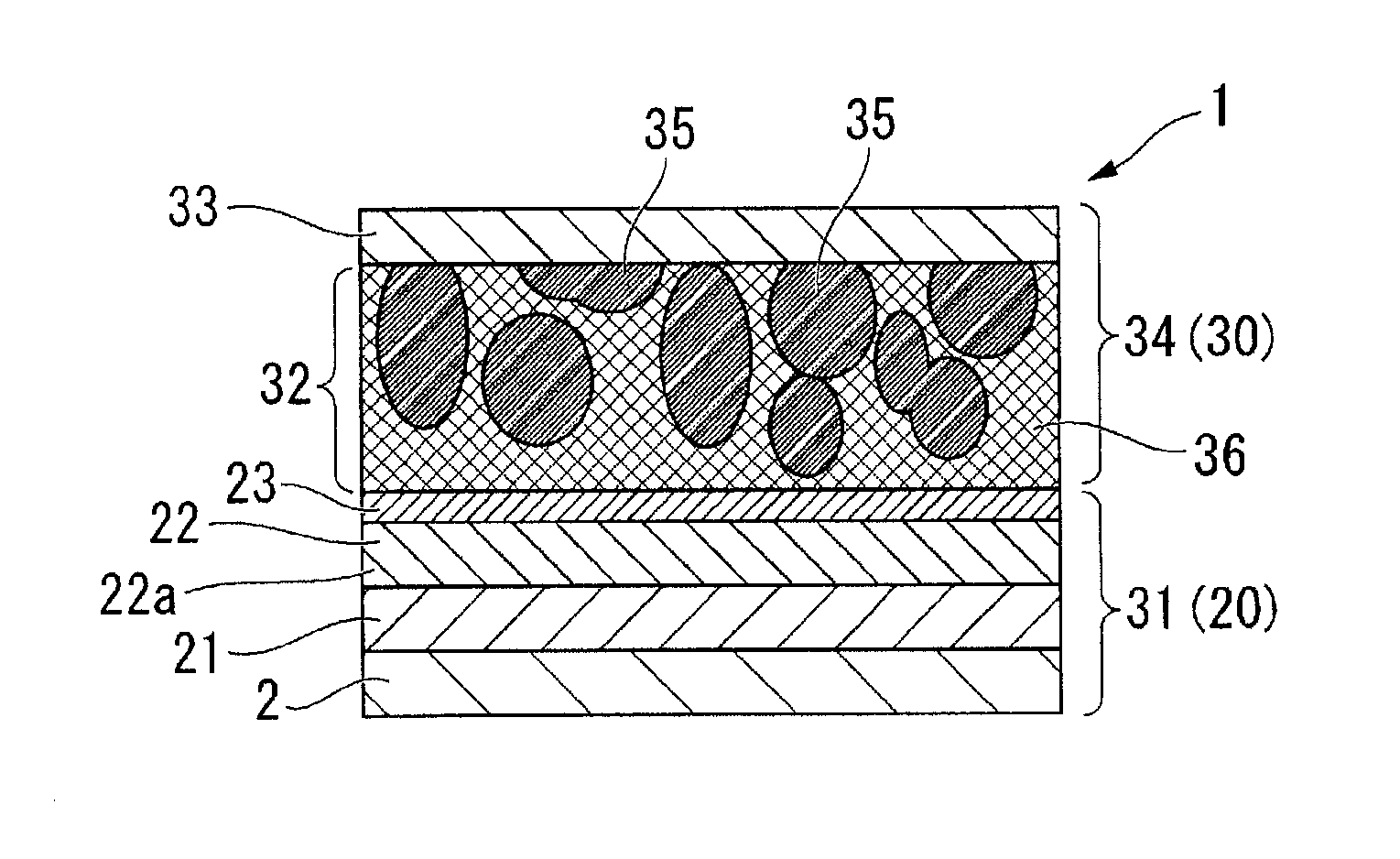Electrode body for lithium battery, and lithium battery
a lithium battery and electrode body technology, applied in the direction of batteries, non-aqueous electrolyte cells, sustainable manufacturing/processing, etc., can solve the problems of short circuit with a positive electrode, difficult to obtain a satisfactory battery output, cycle life deterioration, etc., to prevent short circuit, secure safety, and large output
- Summary
- Abstract
- Description
- Claims
- Application Information
AI Technical Summary
Benefits of technology
Problems solved by technology
Method used
Image
Examples
first embodiment
[0051]FIG. 1 is a schematic view illustrating a lithium battery 1 that is a lithium battery according to the invention.
[0052]In the lithium battery 1, an electrode body for a lithium battery (hereinafter, referred to as an electrode body) 20 is used as a negative electrode, and an electrode body 30 is used as a positive electrode. Specifically, the lithium battery 1 includes a negative electrode body 31 that is the electrode body 20, and a positive electrode body 34 that is the electrode body 30.
[0053]First, description will be given of the electrode body 20. The electrode body 20 is a first embodiment of the electrode body for a lithium battery according to the invention. The electrode body 20 includes a collector electrode 2, a negative electrode active material layer 21 that is provided to come into contact with one surface of the collector electrode 2, a soggy sand electrolyte layer 22 that is provided on the negative electrode active material layer 21, and an inorganic solid el...
second embodiment
[0125]The electrode body 20A is the electrode body according to the invention, and is different from the electrode body 20 illustrated in FIG. 1 in that two laminated structures including a soggy sand electrolyte layer 22 and an inorganic solid electrolyte layer 23 are provided. That is, the electrode body 20A includes a collector electrode 2, a negative electrode active material layer 21 that is formed on the collector electrode 2, a first soggy sand electrolyte layer 22 (22A) that is formed on the negative electrode active material layer 21, a first inorganic solid electrolyte layer 23 (23A) that is formed on the first soggy sand electrolyte layer 22 (22A), a second soggy sand electrolyte layer 22 (22B) that is formed on the first inorganic solid electrolyte layer 23 (23A), and a second inorganic solid electrolyte layer 23 (23B) that is formed on the second soggy sand electrolyte layer 22 (22B).
[0126]The electrode body 20A has the two laminated structures, and thus it is possible ...
third embodiment
[0127]A lithium battery 51 illustrated in FIG. 5 is the lithium battery according to the invention.
[0128]The lithium battery 51 is different from the lithium battery 1 illustrated in FIG. 1 in that an electrode body 20B is used instead of the electrode body 20.
[0129]The electrode body 20B is a third embodiment of the electrode body according to the invention, and is different from the electrode body 20 illustrated in FIG. 1 in that three laminated structures including a soggy sand electrolyte layer 22 and an inorganic solid electrolyte layer 23 are provided. That is, the electrode body 20B includes a collector electrode 2, an a negative electrode active material layer 21 that is formed on the collector electrode 2, a first soggy sand electrolyte layer 22 (22A) that is formed on the negative electrode active material layer 21, a first inorganic solid electrolyte layer 23 (23A) that is formed on the first soggy sand electrolyte layer 22 (22A), a second soggy sand electrolyte layer 22 ...
PUM
| Property | Measurement | Unit |
|---|---|---|
| thickness | aaaaa | aaaaa |
| total thickness | aaaaa | aaaaa |
| thickness | aaaaa | aaaaa |
Abstract
Description
Claims
Application Information
 Login to View More
Login to View More - R&D
- Intellectual Property
- Life Sciences
- Materials
- Tech Scout
- Unparalleled Data Quality
- Higher Quality Content
- 60% Fewer Hallucinations
Browse by: Latest US Patents, China's latest patents, Technical Efficacy Thesaurus, Application Domain, Technology Topic, Popular Technical Reports.
© 2025 PatSnap. All rights reserved.Legal|Privacy policy|Modern Slavery Act Transparency Statement|Sitemap|About US| Contact US: help@patsnap.com



